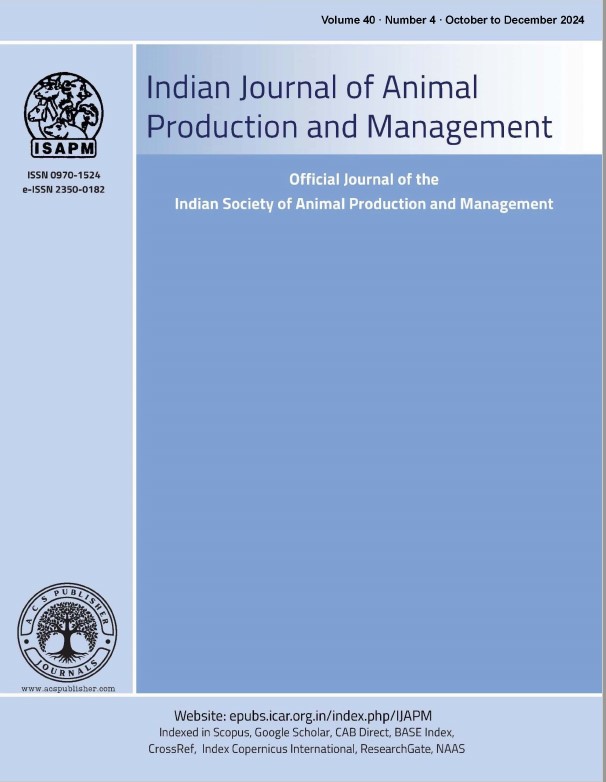Efficiency of Growth in an Organized Herd of Gir cattle in North Saurashtra Agro-climatic Region of Gujarat
DOI:
https://doi.org/10.48165/ijapm.2023.37.3.11Keywords:
Gir cattle, absolute growth rate, body weight gain, relative growthAbstract
The present study was undertaken to find the efficiency of growth performance in Gir calves born (N=52) and raised at Bull Mother Farm, Kamdhenu University, Amreli. The overall birth weight in Gir calves was 24.66 ± 0.40 kg, male calves being significantly (P, 0.004) heavier (9.88%) at birth than female calves. Irrespective of sex, the Gir calves weighed 66.83 kg at 3 months and 109.25 kg at 6 months of age, whereas yearling body weight was 192.82 kg. At 2 years of age, the Gir heifers attained 263.57 ± 17.29 kg body weight, which was above the optimum/ desired breedable body (240-250 kg). The body weight gains from birth to 3 month and from 3 to 6 month growth phases were almost similar, values being 466.9 ± 12.81 and 468.94 ± 20.15 gm/day, respectively. After attaining 1 year of age, the rate of body weight gain showed a diminishing trend, from 312.37 to 270.61 gm/day, with advancement of age. Relative body weight gain, irrespective of sex, was a maximum of 172.88 ± 6.51 % in the birth to 3 month age group, followed by 63.66 ± 2.66% in the 3 to 6 month age group. The findings indicated that due care of the Gir calves, especially during birth to 3 month age is vital to explore their growth potential, as relative weight gain of calves during this phase is maximum (172.88%) for attaining early breedable body weight and in turn, reducing age at first calving.
References
Anonymous. (2023). Annual Progress Report, Year-2022 of Cattle Breeding Farm, Kamdhenu University, Junagadh. Presented at the 19th meeting of the Research Sub
committee on Animal Science & AH and Fisheries Science, Junagadh Agricultural University, Junagadh.
Chaudhari, P. N., Kapadiya, P. S., Gadariya, M. R., Gamit, P. M. and Savaliya, B. D. (2022). Characteristics, Curve and
Persistency of Lactation in Gir Cows. International Journal of Livestock Research, 12(1), 12-18. https://dx.doi.org/10.5455/ijlr.20211027045
Gaur, G. K., Kaushik, S. N. and Garg, R. C. (2003). The Gir cattle breed of India - characteristics and present status. Animal Genetic Resources Information, 33, 21-29. DOI: 10.1017/S1014233900001607.
Kayastha, R. B., Zaman, G. and Goswami, R. N. (2008). Studies on the birth weight of indigenous cattle of Assam. Indian J. Anim. Res., 42(3), 230-231.
Lawrence, T.L.J. and Fowler, V.R. (1997). Growth and puberty in breeding animals. In: Growth of Farm Animals. CAB International, Wallingford, UK, pp. 251.
Mayekar, A. J., Yadav, D. N., Kumar, S., Desai, B. G., Burte, R. G. and Dhekale, J. S. (2017). Evaluation of reproduction performance of Gir cattle (Bos indicus) reared in Hot-Humid condition of Konkan region. Journal of Livestock Biodiversity, 7(2), 93-98.
Parikh, S. S., Savaliya, B. D., Patbandha, T. K. and Makwana, R. B. (2022). Calf, Dam and Sire Factors Affect Birth Weight of Gir Calves. Ind J Vet Sci and Biotech., 18(2), 49-

